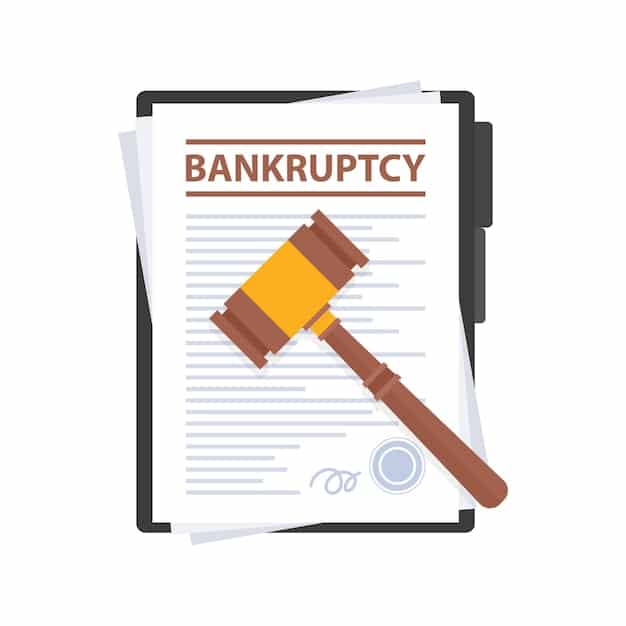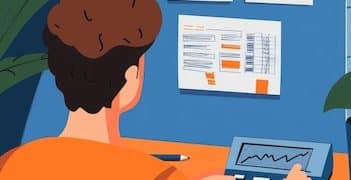Bankruptcy Options: A Comprehensive Guide to Debt Relief Under Chapter 7 and Chapter 13

Navigating debt relief requires understanding bankruptcy options: a comprehensive guide to debt relief under Chapter 7 and Chapter 13, which outlines the distinct pathways these federal laws provide for individuals and businesses to address overwhelming financial burdens and secure a fresh start.
Facing overwhelming debt can be an incredibly stressful experience, leaving many feeling trapped with no clear way out. Fortunately, the U.S. legal system offers structured paths for financial relief, primarily through federal bankruptcy laws. This guide will provide a comprehensive guide to debt relief under Chapter 7 and Chapter 13, exploring the nuances of each, helping you understand their implications, and empowering you to make informed decisions for your financial future.
Understanding the Landscape of Bankruptcy
Navigating bankruptcy is a complex process that demands a clear understanding of its fundamental principles and the various chapters available. It’s not merely about debt elimination; it’s a legal framework designed to give individuals and businesses a chance to reorganize their finances or discharge certain debts, providing a fresh start. This initial overview aims to demystify the core concepts, setting the stage for a deeper dive into Chapter 7 and Chapter 13.
Bankruptcy is enshrined in federal law, meaning its rules are largely consistent across all U.S. states, although state laws can influence certain aspects, particularly regarding exemptions. The primary goal is twofold: to provide honest debtors with a fresh start and to ensure a fair distribution of assets among creditors. This balance is crucial for maintaining economic stability and providing a safety net for those who, through no fault of their own or due to unforeseen circumstances, find themselves in insurmountable debt. Understanding these overarching objectives helps contextualize the specific mechanisms of each bankruptcy chapter.
The Purpose of Bankruptcy Law
At its heart, bankruptcy law serves as a vital economic safety valve. It acknowledges that financial difficulties can arise from various sources, including job loss, medical emergencies, divorce, or business failures. Without an avenue for relief, individuals could be perpetually burdened by debt, hindering their ability to contribute to the economy. Bankruptcy provides a structured process for addressing these issues.
- Fresh Start: Grants debtors a chance to eliminate or restructure debts.
- Fair Distribution: Ensures that creditors receive an equitable share of available assets.
- Protection from Creditors: Imposes an “automatic stay” that immediately halts most collection actions.
- Economic Stability: Prevents widespread economic downturns by allowing individuals and businesses to recover.
Key Terms and Concepts
Before delving into the specifics of Chapter 7 and Chapter 13, it’s essential to grasp some fundamental terms that will recur throughout the discussion. These terms form the vocabulary of bankruptcy and are critical for a comprehensive understanding of the process.
A “debtor” refers to the individual or entity filing for bankruptcy. A “creditor” is any person or entity to whom the debtor owes money. The “bankruptcy estate” comprises all of the debtor’s legal and equitable interests in property at the time the case is filed. An “automatic stay” is a powerful injunctive order that takes effect immediately upon filing, preventing creditors from taking any further collection actions. Exemptions refer to specific types of property that a debtor can protect from being sold to pay creditors. These are often defined by state law.
Finally, “discharge” is the legal term for the elimination of personal liability for certain debts, providing the debtor with a clean slate. It’s the ultimate goal for most individuals filing for Chapter 7, while in Chapter 13, it occurs after successful completion of a repayment plan. Understanding these terms is crucial for navigating the intricacies of the bankruptcy process and for making informed decisions about which chapter might be most appropriate for your specific financial situation.
Chapter 7 Bankruptcy: The Liquidation Path
Chapter 7 bankruptcy, often referred to as “liquidation bankruptcy,” represents one of the most common forms of debt relief for individuals and businesses experiencing severe financial distress. This chapter allows for the discharge of most unsecured debts, offering a swift path to a fresh financial start. However, eligibility for Chapter 7 is subject to strict criteria, primarily the “means test,” which assesses a debtor’s income and expenses. This section will delve into the core aspects of Chapter 7, outlining who qualifies, what debts can be discharged, and the general process involved.
For many, Chapter 7 is a lifeline, providing immediate relief from harassing collection calls and the crushing burden of unmanageable debt. It’s often chosen by individuals with limited income and assets, as it typically involves selling non-exempt property to repay creditors, though many find they lose little to no property due to state and federal exemption laws. The entire process is generally completed within a few months, making it an attractive option for those seeking a quick resolution to their financial woes.
Eligibility and the Means Test
Qualification for Chapter 7 is not universal; it hinges on a stringent assessment known as the means test. This test determines if a debtor’s income is low enough to qualify for Chapter 7. Essentially, it compares the debtor’s average current monthly income during the six months prior to filing with the median income for a household of the same size in their state. If the debtor’s income is below the median, they generally qualify.
If the income exceeds the median, a more detailed calculation comes into play, subtracting allowable living expenses and secured debt payments from their income to determine if they have enough disposable income to repay a significant portion of their unsecured debts. If they do, they may be deemed ineligible for Chapter 7 and might instead consider Chapter 13. The means test is designed to prevent higher-income individuals from unfairly discharging debts that they could reasonably repay over time.
Debts Dischargeable and Non-Dischargeable
A primary benefit of Chapter 7 is the discharge of most unsecured debts. Understanding which debts can be eliminated and which cannot is critical for any potential filer.
- Dischargeable Debts:
- Credit card debts
- Medical bills
- Personal loans
- Certain old tax debts (specific conditions apply)
- Unsecured judgments
- Non-Dischargeable Debts (typically):
- Child support and alimony
- Most student loan debts (unless undue hardship is proven, which is very difficult)
- Certain tax debts (recent ones)
- Debts incurred through fraud or false pretenses
- Fines and penalties owed to government agencies
This distinction is crucial because even if you file for Chapter 7, you will still be responsible for non-dischargeable debts. It’s essential to review your specific debts with an attorney to determine their dischargeability.
The Chapter 7 Process Timeline
The Chapter 7 process is generally straightforward and relatively quick compared to other bankruptcy chapters. After filing the petition, an automatic stay immediately goes into effect, halting most collection actions. A bankruptcy trustee is appointed to oversee the case, primarily tasked with liquidating non-exempt assets (if any) and distributing the proceeds to creditors.
Approximately 30-45 days after filing, the debtor attends a “meeting of creditors” (also known as a 341 meeting), where the trustee and creditors may ask questions under oath about the debtor’s assets and liabilities. Creditors rarely attend these meetings. Following this, if no issues arise and all necessary documents are provided, the debtor typically receives a discharge order within 60-90 days after the meeting, effectively eliminating their dischargeable debts. The entire process, from filing to discharge, often takes about four to six months, offering a relatively rapid resolution to severe financial problems.

Chapter 13 Bankruptcy: The Reorganization Path
Chapter 13 bankruptcy, often referred to as “wage earner’s bankruptcy” or “reorganization bankruptcy,” offers a structured path to debt relief for individuals with regular income who want to repay some or all of their debts over time. Unlike Chapter 7, which involves liquidation, Chapter 13 focuses on creating a repayment plan, typically spanning three to five years, during which the debtor makes regular payments to a bankruptcy trustee. This chapter is particularly appealing to those who do not qualify for Chapter 7 due to the means test, have significant assets they wish to protect, or have debts that are not dischargeable in Chapter 7.
The central component of Chapter 13 is the meticulously crafted repayment plan. This plan details how the debtor will address their debts, including secured debts like mortgages and car loans, as well as unsecured debts such as credit card balances and medical bills. Successful completion of the plan leads to the discharge of remaining eligible debts, offering a comprehensive solution to financial distress without sacrificing valuable assets.
Who Qualifies for Chapter 13?
Eligibility for Chapter 13 is tied to a debtor’s regular income and the amount of their secured and unsecured debts. This chapter is designed for individuals who have a consistent income source, allowing them to make regular payments toward a repayment plan. There are also limits on the amount of debt a filer can have.
- Regular Income: Debtors must have a stable and sufficient income to fund the repayment plan.
- Debt Limits: As of a certain date, there are specific limits for secured debt (e.g., mortgage, car loans) and unsecured debt (e.g., credit cards, medical bills). If a debtor’s total debts exceed these statutory limits, they might not qualify for Chapter 13 and would need to explore other options, such as Chapter 11.
- Credit Counseling: Like Chapter 7, debtors must complete a credit counseling course within 180 days before filing.
These requirements ensure that Chapter 13 is a viable option primarily for those with the means to commit to a multi-year repayment schedule. It provides an avenue for individuals to catch up on missed payments, restructure debts, and ultimately maintain ownership of their valuable assets.
Crafting the Repayment Plan
The repayment plan is the cornerstone of a Chapter 13 bankruptcy. It is a detailed proposal outlining how the debtor intends to repay certain debts over a period of three to five years. The plan must be feasible, proposing payments that the debtor can realistically afford while also meeting legal requirements, such as paying priority debts (like recent taxes and child support) in full.
The plan must address all debts, categorizing them into secured, unsecured priority, and unsecured non-priority. Secured creditors (like mortgage lenders) must receive at least the value of their collateral, while unsecured priority creditors are typically paid in full. Unsecured non-priority creditors, such as credit card companies, may receive a percentage of what they are owed, depending on the debtor’s disposable income and the value of their non-exempt assets. The plan must be approved by the bankruptcy court, a process that involves a confirmation hearing where creditors can object to the plan’s terms. A well-constructed plan balances the debtor’s ability to pay with the legal requirements for fair treatment of creditors.
Benefits of Chapter 13
Chapter 13 offers several distinct advantages, making it a viable option for many struggling with debt.
- Protecting Assets: Debtors can keep all their property, including non-exempt assets, unlike in Chapter 7 where some assets may be liquidated. This is particularly appealing for homeowners who are behind on mortgage payments and wish to avoid foreclosure.
- Curing Defaults: It allows debtors to cure defaults on secured debts, such as mortgages and car loans, over the life of the plan. This means they can catch up on missed payments and retain their property.
- Stopping Foreclosures and Repossessions: The automatic stay immediately halts collection actions, including foreclosures and repossessions, providing immediate relief and time to reorganize.
- Discharging Non-Dischargeable Debts: While many debts are non-dischargeable in Chapter 7, Chapter 13 offers a “super discharge” that allows certain debts (like some divorce-related debts that aren’t alimony or child support, or certain debts arising from willful and malicious injury) to be discharged upon completion of the plan.
- Protecting Co-Signers: Under certain circumstances, Chapter 13 can protect co-signers on consumer debts from collection actions, a benefit not available in Chapter 7.
These benefits highlight Chapter 13’s role as a powerful tool for financial reorganization, providing a structured and manageable way for individuals to address their debts while preserving their assets and working towards a fresh financial start. It offers flexibility and protection that are often not available under Chapter 7, making it a preferred choice for many facing complex financial challenges.
Choosing the Right Bankruptcy Chapter
Deciding between Chapter 7 and Chapter 13 bankruptcy is a pivotal moment in the journey toward debt relief. While both chapters offer a fresh financial start, their mechanisms, eligibility requirements, and outcomes differ significantly. The choice is highly individualized, depending largely on your financial situation, income, assets, and long-term goals. Making an informed decision necessitates a thorough evaluation of these factors, often with the guidance of an experienced bankruptcy attorney. This section will walk you through the critical considerations, comparison points, and the crucial role of legal counsel in selecting the most appropriate path for your circumstances.
The complexity of bankruptcy law means there’s no one-size-fits-all answer. What works for one individual may not be suitable for another. Understanding your current financial standing – your income, debts, assets, and future financial outlook – is the first step. Are you primarily dealing with unsecured debts and have limited assets? Or do you have valuable assets you want to protect, alongside a steady income capable of funding a repayment plan? These questions lay the groundwork for making an educated decision.
Key Factors to Consider
Several key factors should weigh heavily in your deliberations when choosing between Chapter 7 and Chapter 13. Each factor plays a crucial role in determining eligibility, the potential outcome, and the overall impact on your financial life.
The first factor is income and the means test. As discussed, your income level will largely determine if you even qualify for Chapter 7. If your income exceeds the state median and you have disposable income, Chapter 13 might be your only option. Next, consider your assets and exemptions. If you have significant non-exempt assets that you wish to protect, Chapter 13 is generally the better choice, as it allows you to retain all your property. In Chapter 7, non-exempt assets may be sold to pay creditors.
The types of debts you have also matter. While Chapter 7 can discharge most unsecured debts quickly, Chapter 13 is often more effective for dealing with non-dischargeable debts or for catching up on secured debt payments like mortgages or car loans. Finally, your long-term financial goals are paramount. Do you need a quick reset (Chapter 7) or a structured, multi-year plan to reorganize and potentially save valuable assets (Chapter 13)? Your answers to these questions will significantly narrow down your options.
Chapter 7 vs. Chapter 13: A Comparative Look
To further clarify the distinctions, let’s compare Chapter 7 and Chapter 13 across several critical dimensions. This side-by-side comparison can help highlight which chapter aligns better with specific financial scenarios.
- Duration: Chapter 7 is typically completed within 4-6 months, offering a swift resolution. Chapter 13 involves a repayment plan that lasts 3-5 years, requiring a longer commitment.
- Assets: In Chapter 7, non-exempt assets may be liquidated by the trustee. In Chapter 13, debtors retain all their assets, provided they can make the plan payments.
- Debt Repayment: Chapter 7 often results in the discharge of most unsecured debts without any repayment. Chapter 13 requires debtors to repay a portion, or sometimes all, of their debts through a structured plan.
- Eligibility: Chapter 7 has strict income limitations (the means test). Chapter 13 requires a regular income to fund the repayment plan and has debt amount limitations.
- Foreclosure/Repossession: Both chapters impose an automatic stay. However, Chapter 13 specifically allows debtors to cure defaults on secured debts and prevent foreclosure or repossession by including these payments in the plan.
- Debt Types Handled: Chapter 7 is excellent for unsecured debts. Chapter 13 can effectively manage a wider range of debts, including those non-dischargeable in Chapter 7 and arrears on secured debts.
This comparative analysis underscores that each chapter serves distinct purposes and is suited for different financial situations. Your specific needs and circumstances will dictate which path offers the most effective and beneficial form of debt relief.
The Role of a Bankruptcy Attorney
Given the complexities and significant long-term implications of filing for bankruptcy, the guidance of an experienced bankruptcy attorney is invaluable. An attorney can help you navigate the intricate legal landscape, ensuring you make the best decision for your financial future.
An attorney will conduct a comprehensive review of your financial situation, including your income, assets, debts, and future prospects. They can accurately apply the means test to determine Chapter 7 eligibility and assess the feasibility of a Chapter 13 repayment plan. Furthermore, a lawyer can identify which of your assets are exempt, protecting them from liquidation, and ensure that all necessary paperwork is filed correctly and on time, avoiding costly mistakes or case dismissal. They will represent you at the meeting of creditors and during any negotiations with creditors or the trustee. Ultimately, legal counsel provides the expertise and peace of mind needed to confidently pursue the most advantageous bankruptcy option, maximizing your debt relief and paving the way for a successful financial recovery.
Life After Bankruptcy: Rebuilding Your Financial Future
Filing for bankruptcy, whether Chapter 7 or Chapter 13, is not the end of the financial road; it’s a new beginning. While bankruptcy provides immediate relief and a fresh start, it also marks a significant event on your credit report and necessitates a strategic approach to rebuilding your financial health. The journey after bankruptcy is about re-establishing creditworthiness, adopting responsible financial habits, and planning for a secure future. This section will explore the essential steps and considerations for effectively navigating life after bankruptcy, transforming a challenging period into an opportunity for lasting financial stability.
The immediate aftermath of bankruptcy can feel daunting, particularly concerning credit. However, with intentional actions and patience, it is entirely possible to restore your credit score and regain access to financial products and services. The key lies in consistent, disciplined financial management and leveraging the lessons learned from the bankruptcy experience. It’s a marathon, not a sprint, but one that is absolutely achievable with the right strategy.
Credit Score Impact and Recovery
Bankruptcy will significantly impact your credit score, lowering it considerably. Chapter 7 typically remains on your credit report for 10 years, while Chapter 13 remains for 7 years. Despite this, credit recovery can begin almost immediately. Lenders and creditors understand that bankruptcy provides a clean slate, and they will often be willing to extend credit to individuals post-bankruptcy, albeit with higher interest rates initially.
The most effective way to start rebuilding credit is to obtain a secured credit card or a small, secured loan. Secured credit cards require a deposit, which acts as the credit limit, minimizing risk for the lender. By using these responsibly – making small purchases and paying them off in full and on time – you can demonstrate new financial responsibility. Over time, these positive actions will slowly but surely contribute to an improved credit score. It’s crucial to avoid overextending yourself and to monitor your credit report regularly for errors.
Adopting New Financial Habits
Bankruptcy often stems from a lack of effective financial management or unforeseen circumstances. Regardless of the cause, post-bankruptcy is a prime opportunity to cultivate stronger financial habits that will prevent future debt traps.
- Budgeting: Create and stick to a realistic budget that tracks all income and expenses. This is fundamental for living within your means and identifying areas for saving.
- Emergency Fund: Build an emergency savings fund. Aim for at least three to six months of living expenses to cushion against unexpected events like job loss or medical emergencies.
- Debt Avoidance: Be wary of new credit. While rebuilding credit is necessary, avoid accumulating unnecessary debt. Use credit cards sparingly and pay them off monthly.
- Financial Education: Continuously educate yourself on personal finance, investment, and debt management strategies.
- Goal Setting: Set clear, achievable financial goals, such as saving for a down payment, retirement, or higher education.
These habits are not just about recovering from bankruptcy; they are about establishing a solid foundation for long-term financial health and security.
Future Financial Planning
Life after bankruptcy also necessitates thoughtful future financial planning. This extends beyond merely rebuilding credit and encompasses broader strategies for wealth creation and protection.
Consider setting up retirement accounts, investing wisely (once your emergency fund is robust), and exploring options for homeownership if that is a goal. While qualifying for a mortgage immediately after bankruptcy can be challenging, it becomes feasible in a few years with a strong credit history and consistent income. Look into obtaining essential insurance policies, such as health, life, and disability insurance, to protect against future financial shocks. Finally, seek ongoing financial advice from professionals who can help you navigate complex financial decisions and ensure your plans align with your long-term aspirations. Bankruptcy is a powerful tool for relief, but sustained financial well-being is ultimately achieved through diligent planning and responsible actions post-discharge.

Common Misconceptions and Realities
The topic of bankruptcy is frequently surrounded by misunderstandings and stigma, often fueled by incomplete information or anecdotal evidence. Many people hold beliefs about bankruptcy that deter them from seeking necessary relief or lead them to make ill-informed decisions. Separating fact from fiction is crucial for anyone considering this financial pathway. This section aims to debunk common misconceptions and present the realities of filing for Chapter 7 or Chapter 13 bankruptcy, offering a more balanced and accurate perspective on its implications.
Understanding the truth about bankruptcy not only empowers individuals to make better choices but also helps to reduce the psychological burden associated with financial distress. It’s important to remember that bankruptcy laws exist to provide a mechanism for struggling individuals and businesses to get back on their feet, not to punish them indefinitely. Dispelling myths can open the door to genuine relief and a fresh start.
Myths About Bankruptcy
Several persistent myths often distort the public perception of bankruptcy.
- Myth 1: You lose everything. Reality: While Chapter 7 is “liquidation,” state and federal exemption laws allow debtors to keep essential property, such as their home, car, and retirement accounts, up to certain values. Many filers lose no property at all. Chapter 13 allows you to keep all your property.
- Myth 2: You can never get credit again. Reality: While your credit score takes a hit, it immediately begins to recover. Many people successfully obtain new credit cards, car loans, and even mortgages within a few years of filing, often demonstrating responsible financial habits.
- Myth 3: Bankruptcy is a sign of moral failure. Reality: Most bankruptcies are caused by unforeseen circumstances like job loss, medical expenses, or divorce, not irresponsible spending. Bankruptcy is a legal tool designed to help honest but unfortunate debtors.
- Myth 4: Everyone will know you filed bankruptcy. Reality: While bankruptcy filings are public record, they are rarely publicized unless you are a famous individual or a large company. For most people, it remains a private matter.
- Myth 5: You can discharge all debts. Reality: As discussed, certain debts like child support, alimony, most student loans, and recent tax debts are generally non-dischargeable in bankruptcy.
The Realities of Filing
Beyond the myths, certain realities accompany a bankruptcy filing that prospective debtors should be fully aware of.
The process of filing for bankruptcy is a legal one, requiring significant documentation and adherence to court procedures. It demands honesty and full disclosure of all assets, debts, income, and expenses. Misrepresentation can lead to severe consequences, including dismissal of the case or criminal charges. While legal counsel is not strictly mandated, navigating these complexities without an attorney is extremely challenging and often leads to errors.
While bankruptcy provides relief, it does carry certain costs, including filing fees, attorney fees (if applicable), and fees for credit counseling and debtor education courses. These costs need to be factored into your decision-making process. Furthermore, certain types of assets or debts may require specific handling under bankruptcy law, and it’s essential to understand how your unique financial circumstances will be treated. For example, if you have a business, the implications can be different than for a purely personal filing. The reality is that bankruptcy is a serious legal undertaking with long-term impacts, and approaching it with a clear-eyed understanding of its processes and consequences is paramount.
Alternative Debt Relief Options
While Chapter 7 and Chapter 13 bankruptcy offer comprehensive solutions for overwhelming debt, they are not the only avenues available. For some individuals, bankruptcy may not be the most appropriate or necessary step. Several alternative debt relief options exist, each with its own advantages and disadvantages, designed to help individuals manage and reduce their debt burden without resorting to a formal bankruptcy filing. Exploring these alternatives is a crucial part of a holistic approach to debt management and can sometimes provide a more suitable path to financial recovery. This section will outline some of the most common alternatives, emphasizing their mechanisms and suitability for different financial situations.
It’s important to approach debt relief with a clear understanding of all available choices. What might be an effective solution for one person could be ineffective or even detrimental for another. Factors such as the amount of debt, the types of debt, income stability, and personal preferences all play a role in determining the best course of action. Consulting with a financial advisor or a credit counselor can help in evaluating these options against your specific circumstances.
Debt Management Plans (DMPs)
Debt Management Plans (DMPs) are often facilitated by non-profit credit counseling agencies. Under a DMP, the agency negotiates with creditors on your behalf to lower interest rates, waive late fees, and consolidate your monthly payments into one affordable payment. You then pay the credit counseling agency, which in turn distributes the funds to your creditors.
- Mechanism: Consolidates unsecured debts (like credit cards) into a single, often lower, monthly payment.
- Benefits: Can reduce interest rates, stop collection calls, and improve credit over time if payments are made consistently. No negative impact as severe as bankruptcy on your credit report.
- Drawbacks: Does not eliminate debt, only restructures it. Requires strict adherence to the payment schedule, and all enrolled accounts will show on your credit report that you are in a DMP.
- Suitability: Best for individuals with manageable unsecured debt, a stable income, and a willingness to commit to a repayment plan, who want to avoid bankruptcy.
Debt Consolidation Loans
A debt consolidation loan involves taking out a new, larger loan (often at a lower interest rate) to pay off multiple smaller debts. This simplifies repayment into a single monthly payment and can potentially save money on interest.
- Mechanism: Combines multiple debts into one new loan.
- Benefits: Simplifies payments, potentially lowers interest rates, and can improve cash flow.
- Drawbacks: Requires good credit to qualify for a favorable interest rate. If new debt is accumulated, it can worsen the financial situation. Does not reduce the principal amount owed.
- Suitability: Ideal for individuals with good credit who can secure a low-interest loan and have the discipline to avoid accruing new debt.
Debt Settlement
Debt settlement involves negotiating with creditors, often through a debt settlement company, to pay off debts for less than the full amount owed. Creditors may agree to this if they believe it’s their best chance of recovering any money, rather than facing a bankruptcy filing.
- Mechanism: Negotiating a reduced principal amount with creditors.
- Benefits: Can significantly reduce the total amount of debt owed.
- Drawbacks: Can negatively impact credit scores, creditors are not obligated to settle, and settled debts may be considered taxable income by the IRS. It can also lead to collection lawsuits if not handled correctly.
- Suitability: A last resort before bankruptcy, for those with significant unsecured debt and limited ability to pay the full amount, but who also have a lump sum of money available for settlement.
Credit Counseling and Self-Negotiation
For individuals with less severe debt problems or those seeking guidance, credit counseling offers valuable support without formal debt restructuring. Non-profit credit counseling agencies provide financial education, budgeting assistance, and advice on managing debt. Sometimes, with guidance, individuals can even self-negotiate with creditors for better terms.
These alternatives show that bankruptcy is one of several tools in the debt relief toolkit. The choice depends on the severity of the debt, the debtor’s income and assets, and their willingness to engage in different repayment or negotiation strategies. It is always wise to explore all possibilities before committing to any single path, ensuring the chosen solution aligns best with your financial goals and current situation.
Legal Support and Ethical Considerations
Navigating the complexities of debt relief, particularly through bankruptcy, is a significant undertaking that benefits immensely from professional legal guidance. The law is intricate, with nuances that can have profound impacts on an individual’s financial future. Moreover, ethical considerations are paramount in all aspects of debt relief, ensuring fair processes for both debtors and creditors, and establishing a foundation of trust within the legal system. This section underscores the critical role of legal support and delves into the ethical obligations involved in pursuing debt relief, emphasizing transparency, honesty, and professional conduct.
Engaging with legal professionals ensures that all legal requirements are met, potential pitfalls are avoided, and the best possible outcome is achieved. Beyond the procedural aspects, there’s a vital ethical dimension to debt relief that protects the integrity of the system and promotes responsible financial behavior.
The Importance of a Bankruptcy Attorney
Hiring a bankruptcy attorney is not just about having someone fill out paperwork; it’s about securing expert navigation through a complex legal landscape. An attorney provides invaluable support and expertise at every stage of the process.
A qualified bankruptcy attorney helps you understand your legal rights and obligations, advising whether Chapter 7, Chapter 13, or an alternative debt relief option is most suitable for your unique situation. They perform a thorough analysis of your assets, liabilities, and income, ensuring all necessary documentation is accurate and complete. This minimizes the risk of errors that could lead to delays, dismissal of your case, or even accusations of fraud.
They represent your interests in court, at the meeting of creditors, and during any negotiations with the trustee or creditors. Their advocacy can be crucial in protecting your assets, challenging creditors’ claims, and ensuring your repayment plan (in Chapter 13) is fair and confirmable. Ultimately, an attorney not only simplifies a daunting process but also maximizes your chances of a successful discharge and a truly fresh financial start, providing peace of mind during a stressful period.
Ethical Obligations in Bankruptcy Filings
The bankruptcy system operates on principles of honesty and transparency. Debtors have a fundamental ethical and legal obligation to provide accurate and complete information throughout the process.
- Full Disclosure: Debtors must fully disclose all assets, liabilities, income, and expenses. Hiding assets or providing false information can lead to severe consequences, including denial of discharge, criminal charges, and civil penalties.
- Honesty: All statements made under oath, including those in the bankruptcy petition and at the meeting of creditors, must be truthful. Perjury is a serious offense.
- Good Faith: Debtors are expected to file for bankruptcy in good faith, meaning they genuinely seek relief from insurmountable debt, not to abuse the system or defraud creditors.
- Fiduciary Duty (for attorneys): Bankruptcy attorneys have a fiduciary duty to represent their clients’ best interests within the bounds of the law, providing honest advice and ethical representation. They must ensure clients understand their obligations and the consequences of their actions.
These obligations are crucial for maintaining the integrity of the bankruptcy system. They ensure that the relief provided is genuinely for those who need it, and that creditors are treated fairly under the law. Adhering to these ethical principles not only ensures a smoother bankruptcy process but also reinforces the debtor’s commitment to a responsible financial future. The intersection of legal support and ethical conduct creates a robust framework for effective and fair debt relief, benefiting all parties involved.
| Key Point | Brief Description |
|---|---|
| ✔️ Chapter 7 | A liquidation bankruptcy for low-income individuals to discharge most unsecured debts swiftly (4-6 months). |
| 🔄 Chapter 13 | A reorganization bankruptcy for individuals with regular income to repay debts through a 3-5 year plan, retaining assets. |
| 🛡️ Debt Protection | Both chapters offer an automatic stay, halting collections, but Chapter 13 protects assets and can cure defaults on secured debts like mortgages. |
| ⚖️ Attorney Role | A bankruptcy attorney is crucial for navigating legal complexities, ensuring compliance, and maximizing the chances of a successful discharge. |
Frequently Asked Questions About Bankruptcy
No, bankruptcy typically discharges most unsecured debts like credit card bills and medical expenses under Chapter 7. However, certain debts such as child support, alimony, most student loans, recent tax debts, and debts incurred through fraud are generally not dischargeable under any chapter. Understanding this distinction is crucial before filing.
A Chapter 7 bankruptcy filing typically remains on your credit report for 10 years from the filing date. A Chapter 13 bankruptcy, which involves a repayment plan, usually stays on your report for 7 years from the filing date. Despite these records, you can begin rebuilding your credit relatively quickly with disciplined financial habits.
In many cases, yes. Under Chapter 7, state and federal exemption laws allow you to protect a certain amount of equity in your home and car. Under Chapter 13, you typically get to keep all your property, including your house and car, as long as you make your plan payments to cover secured debt arrears and ongoing payments.
While it is legally possible to file for bankruptcy without an attorney, it is strongly advised against. Bankruptcy law is complex, and errors can lead to case dismissal or loss of assets. An experienced attorney ensures all paperwork is accurate, deadlines are met, and your rights are protected, significantly increasing the likelihood of a successful discharge.
Chapter 7 is a liquidation bankruptcy that discharges most unsecured debts quickly (4-6 months) for individuals with low income and assets. Chapter 13 is a reorganization bankruptcy for individuals with regular income who repay debts through a 3-5 year plan, allowing them to keep assets and catch up on secured loan payments like mortgages.
Conclusion
Navigating the complexities of overwhelming debt can be daunting, but the legal frameworks of Chapter 7 and Chapter 13 bankruptcy offer structured pathways to a fresh financial start. As this comprehensive guide has detailed, both options provide distinct benefits and are tailored to different financial circumstances. Whether seeking a swift discharge of unsecured debts through Chapter 7 or a detailed reorganization plan to protect assets under Chapter 13, understanding the intricacies of each is paramount. Ultimately, the decision of which path to pursue hinges on individual income, assets, debt types, and long-term financial goals, often best illuminated with the expert guidance of a bankruptcy attorney. By making an informed choice and committing to responsible financial habits post-bankruptcy, individuals can successfully rebuild their financial future and achieve lasting stability.





